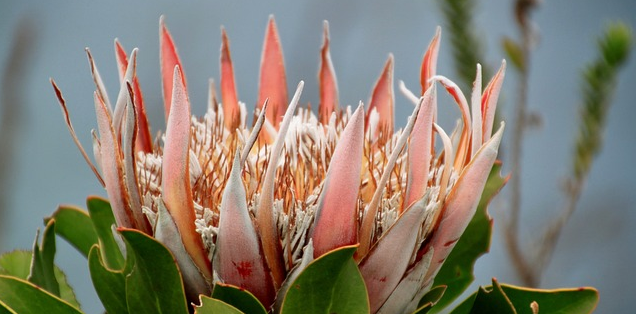
June: King Protea
This month, we’re exploring the King Protea, South Africa’s national flower.
In South African culture, proteas have long been regarded as symbols of hope, resilience, and strength. The flower is often used in traditional healing practices and is believed to bring good luck and fortune.
History and Ecology

The King Protea, or protea cynaroides, is also commonly known as the Giant Protea, Honeypot, or King Sugar Bush. It is widely distributed in South Africa, especially in the fynbos region, but it also grows in tropical climates all over the world.
The Protea family currently has about 1400 species , virtually all in the southern hemisphere spanning from Australia to New Zealand to Africa. No one knows where they originated, but based on fossils, we do know that Proteas were around at the same time dinosaurs roamed the planet. Proteas date back 300 million years, making them one of the oldest flowers we’ve documented.
| The Protea Project |
What’s in a name?
King Protea: protea cynaroides
The genus name, protea, honors the Greek god Proteus. He was Poseidon’s son and was known as the sea’s shepherd as he took care of Poseidon’s seals. One of his powers was that he could tell the future, and for this reason many people sought him out. But Proteus had a trick to keep his information to himself; he could change forms into any living or non-living thing. In mythology, in order to get Proteus to tell you your future, you had to grab him as he changed forms. If you could hold on as he changed, then when you outlast his attempts he will tell you your future.
South Africa picked protea cynaroides as their national flower for this reason. As the native South Africans note in the Protea Project, “This mythology is apt for our national flower. In order to progress in the future one must hold onto what one has. We must ensure that we do not lose our plants and animals. We must not destroy our rivers, veld and mountains - either by over-development or ignorance. The first step to intelligent tinkering is to keep all the pieces safe.” Thus, the mythology plays beautifully into the sentiment.
The second half of the name “cynaroides” is less exciting. It comes from the artichoke family Cynara due to the flower’s resemblance to an artichoke.
And tadaa! We have Protea cynaroides.
Protea and Wildfires
One aspect of proteas I find to be really interesting is that they’ve found strategies to resist and even harness the wildfires known to occur regularly in their climate. To combat raging wildfires, which are necessary in the fynbos region, King Proteas do four things:
Firstly, they don’t produce seeds until later in the season, a concept known as serotiny in plant botany. Some serotinous plants hold their seeds until a disturbance such as a fire. Next, the proteas grow along the ground where fires are coolest to keep their stems from completely burning up. They produce a thick bark which protects both the stems and buds from extreme heat. Lastly, these plants conceal their hand and hide underground. Protea have an extensive rootstocks, which are thick underground stems. After a fire has killed the above ground plants, these underground stems pop out and produce a whole new plant.
Fun Facts!
Proteas are a popular flower for floral bouquets! They’ve recently become more popular as an adventurous wedding bouquet.
Some proteas are known as "pyrophylic" (fire-loving) because many species need to burn for their dormant buds to germinate and continue living.
Proteas are a great example of Fibonacci spirals in plant development. It was discovered that spiral bud development follows the well-known Fibonacci sequence, with new buds or leaves forming at corresponding angles around the stem. Flowers like sunflowers and protea give a clear image of what that looks like.

This aspect of plant development was my favorite to learn about in college. As it turns out, there is a chemical called actin in plants that nearly runs the whole show. Actin accumulation is what tells the leaves or buds where they should sprout next, and it acts along this sequence. If you’d like to dive down that rabbit hole, The Protea Project has a great page exploring it!
| Fibonacci + Protea |
Thank you for joining and exploring the King Protea! One of my favorite parts of writing this blog is coming across plants that I’m familiar with but don’t know much about. Protea are one of those, and I loved getting to deep dive into their history. I hope you enjoyed the interesting nuances to protea and some of the fascinating science behind their proliferation.
|
|
|